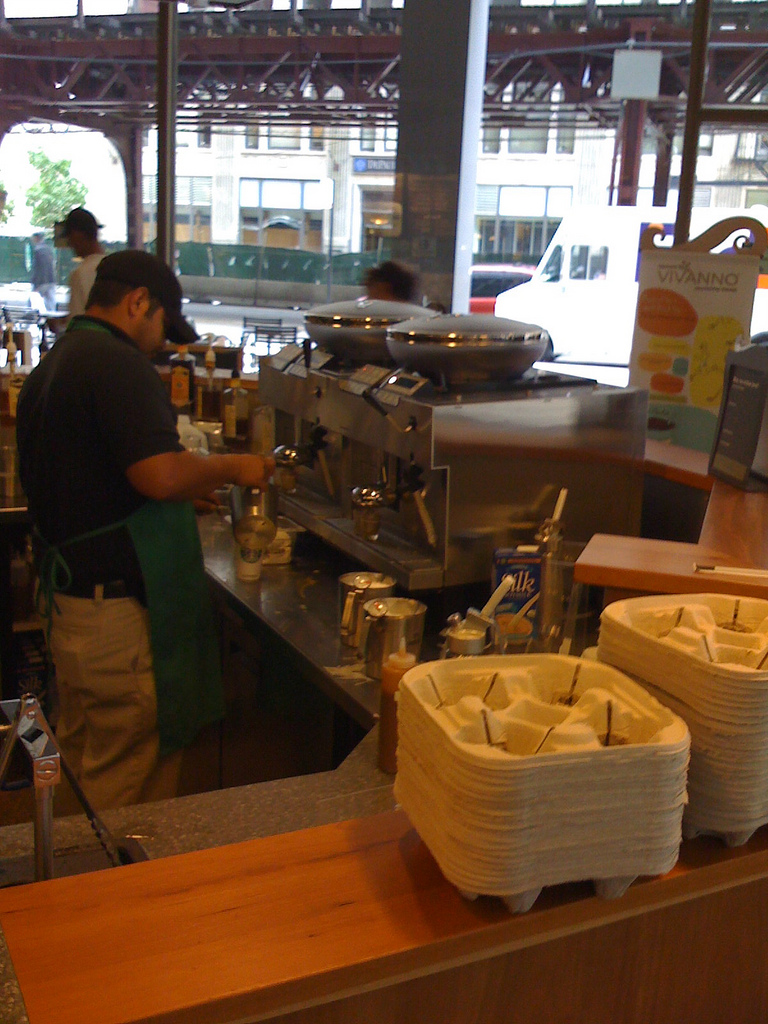A lot of people in the specialty coffee industry like to beat up on Starbucks and in a lot of ways they deserve it. They often roast the life out of a lot of their beans, they have destroyed many people’s understanding of traditional espresso drinks (like the macchiato) and they have removed the barista from the equation almost entirely through the use of super-automatic espresso machines. However accurate those accusations are, we still must recognize the fact that Starbucks brought espresso to the mainstream in America, which before Starbucks, was drinking things like Folgers Crystals and stale coffee from a glass pot kept on a heat plate next to the rolling corn dogs.
Starbucks started with a great vision. Howard Schultz experienced coffee romance first-hand in Italy and wanted to bring that romance to the States and he did just that and he did it well. So well, the Starbucks brand became a status symbol.
Starbucks doesn't sell coffee any more, they sell status symbols. i.e. "See me with my Starbucks cup." Very effective branding.
— Michael Wright (@OilSlickCoffee) September 11, 2014
Starbucks has now reached a point that people want to be seen and identified with the Starbucks brand. It’s a social status to be able to 1) afford a $4 cup of coffee and 2) be in that group of people who can afford a $4 cup of coffee. That’s what great branding does.
By 1991, Starbucks was on the cusp of becoming a publicly-owned company and in those early years, it was still for the right reasons:
Starbucks was attempting to accomplish something more ambitious than just grow a profitable enterprise. We had a mission, to educate consumers everywhere about fine coffee. We had a vision, to create an atmosphere in our stores that drew people in and gave them a sense of wonder and romance in the midst of their harried lives. We had an idealistic dream, that our company could be far more than the paradigm defined by corporate America in the past.
(Schultz, 1999, p. 18)
See also: What Starbucks Means To Specialty Coffee

Where’s the life in that? Where’s the creativity? Sure, they can experiment with drink recipes and come up with some new milk-ified, sweet-bomb bastardization of a coffee drink but that doesn’t contribute to the exploration of the quality of coffee.
The change to super-automatics was one of their worst transgressions in my mind, but certainly not the only one. There’s also the drift away from coffee itself, towards “coffee-related” products.
In August 1994, Pepsi and Starbucks publicly announced the formation of the North American Coffee Partnership, with the goal of creating new coffee-related products for mass distribution, including cold coffee drinks in a bottle or can."
(Schultz, 1999, p. 18)
These bottled and canned drinks are made from a synthesized coffee extract, not coffee itself:
It was wild: a coffee company, hiring scientists and investing millions in R & D. It’s a long way from espresso. It’s a long way from immunology. What it wasn’t far from was the market. (Emphasis mine)
(Schultz, 1999, p. 18)
It’s a long way from espresso indeed.
While Starbucks has done a superb job in creating a successful, global brand, which introduced espresso drinks to mainstream America, that brand has since drifted too far from the original intent; quality coffee. In their early days, they stuck to the spirit of quality coffee and as a business they were of a size where they could maintain control of that spirit and the quality and were able to educate their customers and bring them along the journey. Unfortunately, as they grew exponentially, they also rapidly lost sight of that spirit and instead pursued growth and profits at the cost of quality. There is a happy medium. Starbucks just needs to find it again.
I also hope this can be a learning point for La Colombe and Blue Bottle*, both of which recently received cash infusions to expand operations with multiple locations.
- Schultz, H. (1999). Pour Your Heart Into It: How Starbucks Built a Company One Cup at a Time. Hachette Books.
